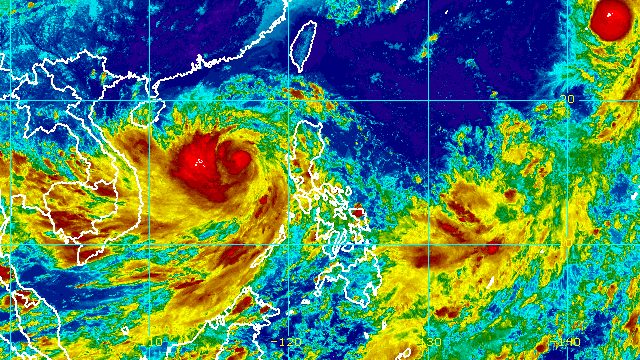SUMMARY
This is AI generated summarization, which may have errors. For context, always refer to the full article.

MANILA, Philippines – Typhoon Karding (Noru) is expected to leave the Philippine Area of Responsibility (PAR) on Monday evening, September 26, but the southwest monsoon or hanging habagat is bringing rain to the western parts of Southern Luzon and the Visayas.
The Philippine Atmospheric, Geophysical, and Astronomical Services Administration (PAGASA) said in its 5 pm bulletin on Monday that Karding was already 425 kilometers west of Dagupan City, Pangasinan.
The typhoon is moving west over the West Philippine Sea at 30 kilometers per hour (km/h), heading for Vietnam.
It slightly intensified on Monday afternoon, with its maximum sustained winds increasing back to 140 km/h from the previous 130 km/h. Its gustiness went back up to 170 km/h from 160 km/h.
But since Karding is moving further away from Philippine landmass, there are no more tropical cyclone wind signals and no more rainfall warnings in effect. At the height of Karding’s onslaught, Signal No. 5 was the highest wind signal raised and the rain reached torrential levels.
The southwest monsoon, however, will trigger monsoon rain in Palawan on Monday evening.
Scattered rain showers and thunderstorms are also expected in the following areas:
- Metro Manila
- Pangasinan
- Zambales
- Bataan
- Cavite
- Batangas
- Aurora
- Quezon
- Occidental Mindoro
- Western Visayas
PAGASA warned that flash floods and landslides are possible.
As for coastal conditions, the western seaboards of the Philippines will have moderate to rough seas due to Karding and the southwest monsoon. Waves will be 1.5 to 4 meters high, which may be risky for small vessels.

Karding is the Philippines’ 11th tropical cyclone for 2022 and the third tropical cyclone for September. At its peak, it was a super typhoon with maximum sustained winds of 195 km/h.
Karding first made landfall as a super typhoon in Burdeos, Quezon, at 5:30 pm on Sunday, September 25, followed by another landfall as a typhoon in Dingalan, Aurora, at 8:20 pm.
It then crossed Nueva Ecija, Tarlac, and Zambales, before emerging over Zambales’ coastal waters early Monday.
Nueva Ecija was placed under a state of calamity on Monday.
Bulacan is also among the hardest-hit provinces. At least five people died in Bulacan, according to the National Disaster Risk Reduction and Management Council.
PAGASA also continues to monitor Tropical Storm Kulap, located outside PAR.
Kulap was last spotted 2,270 kilometers east northeast of extreme Northern Luzon on Monday afternoon, moving north northwest at 20 km/h.
The tropical storm has maximum sustained winds of 65 km/h and gustiness of up to 80 km/h.
PAGASA Weather Specialist Veronica Torres said Kulap only has a slim chance of entering PAR.
PAGASA expects 7 to 11 tropical cyclones to enter or develop inside PAR from September 2022 to February 2023. Per month, these are the weather bureau’s estimates:
- September 2022 – 2 or 3
- October 2022 – 2 to 4
- November 2022 – 2 or 3
- December 2022 – 1 or 2
- January 2023 – 0 or 1
- February 2023 – 0 or 1
– Rappler.com
Add a comment
How does this make you feel?










There are no comments yet. Add your comment to start the conversation.